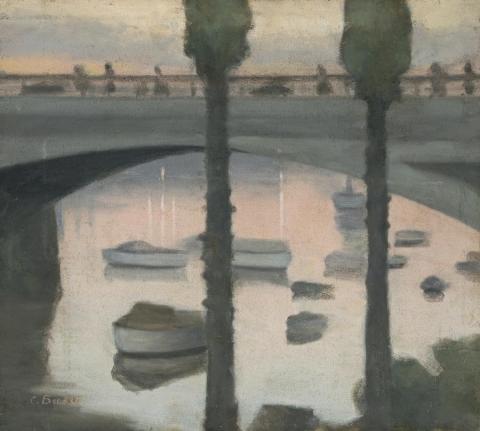PRINCES BRIDGE, 1930
Clarice Beckett
oil on board
45.0 x 50.0 cm
signed lower left: C. Beckett
Rupert Steele, Esq, Melbourne
Leonard Joel, Melbourne, 2 November 1998, lot 1334
Private collection, Melbourne
Deutscher~Menzies, Melbourne, 3 May 2000, lot 48
Martin Browne Fine Art, Sydney
Private collection, Sydney
Clarice Beckett Exhibition, Athenaeum Gallery, Melbourne, October 1930, cat. 53
Memorial Exhibition: Clarice Beckett, Athenaeum Gallery, Melbourne, 4 - 6 May 1936, cat. 3
Homage to Clarice Beckett: Idylls of Melbourne and Beaumaris, Rosalind Humphries Galleries, Armadale, Melbourne,30 October - 20 November 1971, cat. 39
Clarice Beckett Retrospective Exhibition 1921 - 1935, Realities, Melbourne, 11 October - 1 November 1979, cat. 51 (lent), held in conjunction with the launch of Rosalind Humphries’ book, Clarice Beckett: The Artist and Her Circle
Clarice Beckett: Politically Incorrect, The Ian Potter Museum of Art, the University of Melbourne, 5 February - 28 March 1999, cat. 47, (col. illus.), touring state and major regional art galleries in Victoria, New South Wales, South Australia and Tasmania during 1999 - 2000
‘The Palette’, Bulletin, 29 October 1930, p. 33
Fraser, F., & Palmer, N., (eds.), Centenary Gift Book, published as part of the Melbourne Centenary celebrations for The Women’s Centenary Council, Robertson and Mullins Limited, Melbourne, 1934, illus. facing p. 8
Hollinrake, R., Clarice Beckett: The Artist and Her Circle, The Macmillan Company of Australia Pty Ltd, Melbourne, 1979, pl. 23 (illus.)
Hollinrake, R., Clarice Beckett: Politically Incorrect, the Ian Potter Museum of Art, the University of Melbourne, Melbourne, 1999
One of the most striking features of the work of Australia's leading women artists of the twenties and thirties is the boldness of their compositions and colour. One need only recall the powerful geometricism of Margaret Preston's still life paintings of 1927-8, or those of Evelyn Syme and Dorrit Black. Princes Bridge, 1930, by Clarice Beckett places her work firmly among this group of outstanding artists, the challenging design yielding only to that soft focus so characteristic of her painting. She, like her contemporaries, took the everyday and transformed it into something new and profoundly beautiful. Unique? Certainly, and with a very definite sense of time and place. Where else could this be but Melbourne of the 1930s. There is also that magical mix of simplicity and profundity, of the universal found in the local. What could be more straightforward than the span of a bridge across still waters with a sunset as background? In Beckett's hands it becomes a meditation on being and the beauty of the moment, arresting in its powerful verticals balancing the curve and horizontal line of the bridge. The people scurrying across it are stilled. The calm reflection of the boats in the waters of the river and the accents of the trees, a blend of form and silhouette, create a captivating mood of tranquillity. While the influence of Max Meldrum is ever present in her tonalism, it is not that slavish acceptance of a theory found in some of his pupils. For Beckett, the imitation of reality gives way to the creation of an atmosphere of serenity, of silence within its stillness. Paradoxically, the inter-play between the lights and darks with their many inter-tones is akin to music. Her work was so striking that by 1930 one critic was moved to describe her as ‘the most original painter in Australia.’1 Reviewing her exhibition at the Athenaeum Gallery, he wrote of her achievement through abandoning ‘conventions’, ‘the unexpectedness of her color harmonies’, and ‘fineness of her vision’. Describing ‘the uncanny quality of Miss Beckett’ as ‘her power to give us a new and lyrical emotion by purely realistic methods’, the Bulletin writer single out Princes Bridge and another painting as those in which ‘that power is patent…’ The inclusion of Princes Bridge in all the major retrospective exhibitions of Beckett's art confirms its position as one of her foremost works.
1. Bulletin, Sydney, 29 October 1930, p. 33
DAVID THOMAS
